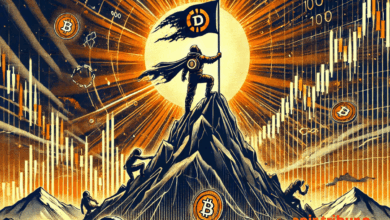Old money looking for new things: Wall Street accelerates ‘on the chain’

In the future, Web3 Wallet will be able to connect global assets and easily complete transactions at any time.
Author: Jason Jiang, OKG Research
From the Bitcoin Spot ETF to the crypto wave, the institutional power represented by Wall Street is profoundly influencing and changing the direction of the cryptocurrency market, and we believe this power will become even stronger in 2025. OKG Research has launched the “#ChainOnWallStreet” series of research to continue focusing on institutional innovation and practice In the Web3 space, to find out how major institutions like BlackRock and JPMorgan Chase are embracing innovation? How will token assets, cross-chain payments, and decentralized finance shape the future financial landscape?
This article is the first in a series of “#ChainWallStreet” studies.
When predicting the cryptocurrency market in 2025, investment management firm VanEck boldly predicted that Coinbase would take the unprecedented step of tokenizing its shares and publishing them on its underlying blockchain. It looks like the prediction is coming true: Jesse Pollack, lead developer of the Core Chain, recently revealed that providing a dollar coin on the Core Chain is “something we are working on in the new year” and predicts that “every asset in the world will eventually be on the base.”
It is not clear whether Coinbase will be able to realize its plan, but since it is using its own stock as a springboard to explore the token, Wall Street is also accelerating “Onchain.”
Wall Street begins to migrate to the chain
Since 2024, the cryptocurrency market has witnessed rapid growth and the frontiers of innovation have continued to expand. The primary driving force behind this comes from cryptocurrency ETFs promoted by Wall Street institutions represented by BlackRock. Today, these institutions are turning more attention to the field of coding.
BlackRock CEO Larry Fink said that while approval of cryptocurrency ETFs is important, these are “stepping stones” toward broader tokenization of other assets. As tokenization booms, Wall Street is pushing more assets and companies onto the chain, allowing traditional finance and cryptocurrency innovation to meet more sparks in the digital space.
Although the tokenization of financial assets has been around since 2017, it has only recently taken off. In contrast to early explorations that focused on permissioned chains, more and more tokenization practices are converging on public chains, and Ethereum has become the first choice for institutional tokenization. These institutions no longer reject decentralization, but instead actively explore the scope of crypto’s impact, and try to provide a new experience by recombining assets and technologies. As Coinbase said, “Web3” is gradually being replaced by the more convenient “Onchain”.
Only this time, the protagonist is no longer just cryptocurrency, but also many assets from the physical world, such as stocks. As the largest cryptocurrency exchange in the United States, Coinbase is the most popular stock target in the token market at this point. According to rwa.xyz data, as of January 2025, the total market capitalization of tokenized shares is approximately US$12.55 million, of which nearly 50% are tokenized shares with Coinbase as the target. In addition, stock tokens for Nvidia, Tesla, and Apple, among the seven giants in US tech stocks, also appear frequently on the chain.
Figure Tokenized Stock Market Structure
Coinbase plans to tokenize and issue its shares on the underlying chain, which will not only allow investors to trade their shares directly on-chain, but will also further integrate the trading platform, the underlying chain and the on-chain asset ecosystem, and explore a compatible and possible equity tokenization model in the United States, allowing it to maintain Leading the competition for crypto-financial innovation.
This design is definitely not just for the $COIN token. Maybe, as Jesse Pollack said, they hope that all the assets in the world will be on the main chain. But compared to this, accelerating the migration of major global assets to the chain through tokenization is a more predictable future.
Although the token, like other innovative concepts, is also subject to skepticism, the concept focused on democratizing access to investment opportunities and streamlining the efficiency of capital flows has been deeply rooted in people’s minds. The on-chain availability demonstrated by stablecoins, BUIDL funds and other token assets has proven its value, and more and more asset classes are also moving to the chain: not only shared private credit, bonds, funds and gold, but also assets such as agricultural products, carbon credits, and rare earths.
According to the OKLink Research Institute, we will see Wall Street continue to “Onchain” more frequently in 2025, promoting the tokenization system to be richer and more mature: not only will the amount of on-chain tokenized assets for stablecoins exceed at least 30 billion USD, but we will see Also, more companies are entering the tokenization space under the leadership of Wall Street and bringing more valuable assets to the chain. Although the amount of tokenization of these assets may not be “exaggerated,” it is still very significant.
Towards a more democratic financial future
60 years ago, when you bought a security or pledged it as collateral, you might have to wait five days for a paper certificate to confirm the transaction. Later, as the number of paper certificates increased and settlement of transactions became unmanageable, Wall Street was forced to begin trying to use computers to track securities.
Today, gaining competitive business advantages from better or faster technology is a ubiquitous part of modern finance. Whether it’s BlackRock and Goldman Sachs, or Citigroup and JP Morgan Chase, almost everyone on Wall Street has identified tokenization as the trend of the future and is embracing the changes brought about by tokenization. Compared to passive financial informatics, tokenization is the next step of change that finance is actively embracing.
In this shift, there is no longer a problem with publishing assets on-chain through tokenization. The future challenge is how to increase demand for token assets and solve the on-chain liquidity problem. The unparalleled success of traditional securities is largely due to their high liquidity and low transaction costs. If tokenized assets are only locked on-chain or can only be traded on the secondary market with limited liquidity, their actual value will be very limited as well.
Nadine Shukr, who was in charge of the digital assets division at State Street Bank, once expressed a similar view: “The bank works with a company to issue token bonds and then issues a press release. What happens next? Nothing happens. These bonds are like rocks. traded in the markets.”
How can the problem of liquidity in the token market be solved? Different institutions may have different solutions, but in my opinion, the most straightforward way is to speed up the process of tokenizing high-quality assets. Only by accumulating enough high-quality assets on-chain can we attract more users and funds to move to the chain, thus solving the liquidity problem.
McKinsey predicts that the scale of tokenization will be close to 2 trillion US dollars by 2030
With enhanced network effects, coding is now moving from beta releases to large-scale deployment. However, as McKinsey predicts, tokenization cannot be achieved overnight, and there will be a significant lag in the tokenization process for different assets: the first wave will be driven by use cases with proven returns on investment and current scale, followed by use cases for asset classes with smaller existing markets. , or the benefits are less obvious, or require solving more serious technical challenges.
When the first wave of on-chain assets explore compatible and workable business models and bring enough interest and liquidity to the on-chain market, perhaps tokenization will create a freer and more democratic “shadow” capital market in the future. By giving investors more free investment opportunities and allowing more companies to complete financing more conveniently, tokenization will bring about profound changes in the supply and demand sides of assets, gradually removing the barriers between the off-chain world and the on-chain world, truly shaping the new global financial system.
Author: 欧科云链OKLink
This article reflects the opinions of the PANews columnist and does not represent the position of PANews. PANews does not assume legal responsibility. The article and opinions do not constitute investment advice.
Image source: 欧科云链OKLink If there is any violation, please contact the author to remove it.
https://cdn-img.panewslab.com/panews/2025/01/10/images/S4SpdtiUX1.png




